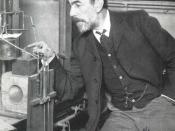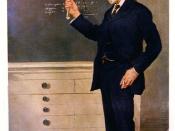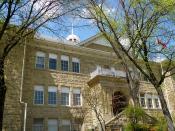Ramsay, Sir William. 15 Feb http://www.britannica.com/nobel/micro/493_80.html,1997Ramsay, Sir William." Encyclopedia Britannica. 2007. Encyclopedia BritannicaOnline. 21 Feb. 2007 .
William Ramsay. 15 Febhttp://chemicalheritage.org/classroom/chemach/periodic/ramsay.html. 2007SIR WILLIAM RAMSAYWilliam Ramsay was born in Glasgow on October 2, 1852, the son of William Ramsay and Catherine Robertson. He was a nephew of the geologist, Sir Andrew Ramsay.
Until 1870 he studied in his native town, following this with a period in Fittig's laboratory at Tubingen until 1872. While there his thesis on orthotoluic acid and its derivatives earned him the degree of doctor of philosophy.
On his return to Scotland in 1872 he became assistant in chemistry at the Anderson College in Glasgow and two years later secured a similar position at the University there. In 1880 he was appointed Principal and Professor of Chemistry at University College, Bristol, and moved on in 1887 to the Chair of Inorganic Chemistry at University College, London, a post which he held until his retirement in 1913.
Ramsay's earliest works were in the field of organic chemistry. Besides his doctor's dissertation, about this period he published work on picoline and, in conjunction with Dobbie, on the decomposition products of the quinine alkaloids (1878-1879). From the commencement of the eighties he was chiefly active in physical chemistry, his many contributions to this branch of chemistry being mostly on stoichiometry and thermodynamics. To these must be added his investigations carried on with Sidney Young on evaporation and dissociation (1886-1889) and his work on solutions of metals (1889).
It was however in inorganic chemistry that his most celebrated discoveries were made. As early as 1885-1890 he published several notable papers on the oxides of nitrogen and followed those up with the discovery of argon, helium, neon, krypton, and xenon. Led to the conclusion by different paths and, at first, without working together,


